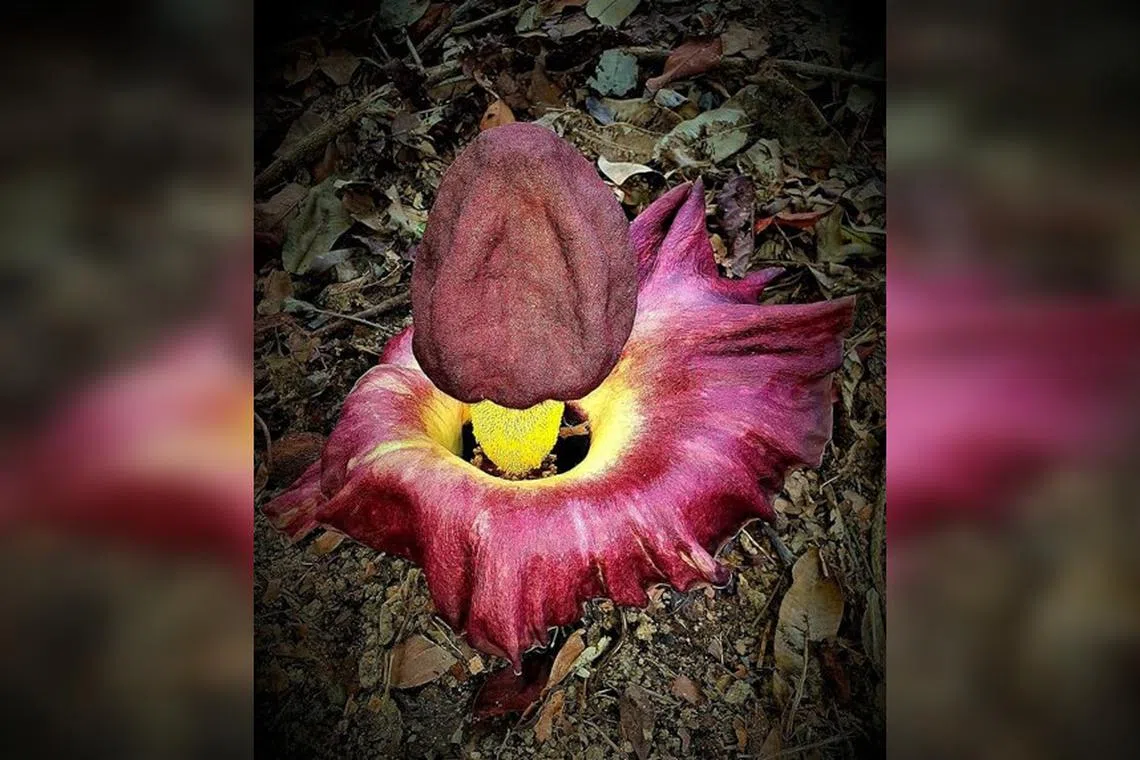Rare corpse flower blooms in Botanic Gardens over the weekend
Sign up now: Get ST's newsletters delivered to your inbox

The flower emits a foul smell similar to a decomposing animal to attract pollinators such as flies and beetles.
PHOTO: JOHN LEE
Follow topic:
SINGAPORE - A big, foul-smelling flower of an exotic plant known as the elephant foot yam has fully bloomed over the weekend in the Singapore Botanic Gardens.
Planted by the Gardens in 2014, the Amorphophallus paeoniifolius blooms once every few years and the flower typically lasts for at most three days before it starts to wilt.
It emits a foul smell similar to that of a decomposing animal to attract pollinators such as flies and beetles, Dr Thereis Choo, coordinating director of Singapore Botanic Gardens, told The Straits Times.
Mr John Lee, 51, chanced upon the corpse flower – so called for the stench it emits – on Feb 26 during a stroll through the Healing Garden in the Gardens.
He said it was about 55cm in height and about 40cm in width.
“I recognised the shape of the flower from afar and was excited to see that it was really a corpse flower,” said Mr Lee, a wildlife photographer.
As he approached the plant, the stench resembled that of rotting flesh, and he felt the urge to vomit. The flower was nestled among other small plants in a shaded part of the garden.
Mr Lee said he missed the chance to see the flower over a year ago.

The wilted flower of the elephant foot yam in the Healing Garden of Singapore Botanic Gardens on March 2, 2023.
ST PHOTO: LIM YAOHUI
Its last sighting in Singapore was reported to be at the foot of a Housing Board block in Sembawang in June 2021.
Mr Lee had made a trip to Sembawang then to see it, but it was gone by the time he arrived.

Its last sighting in Singapore was reported to be at the foot of a Housing Board block in Sembawang in June 2021.
PHOTO: ST FILE
Dr Choo said visitors should refrain from touching, stepping and damaging the elephant foot yam plant, including other plants and trees in the surrounding area.
She added that the elephant foot yam plant has medicinal properties – its dried tubers are used in traditional medicine to relieve digestive problems, while its fresh roots are used as cough medicine to clear mucus and phlegm.
“Although it has edible plant parts, they need to be thoroughly cooked to break down the irritant calcium oxalate crystals, which would otherwise cause stinging and burning,” said Dr Choo.
The elephant foot yam plant, which can reach heights of 2.5m, is native to countries such as Madagascar, China, Papua New Guinea, Indonesia and Malaysia. It is not known to grow spontaneously in Singapore.


